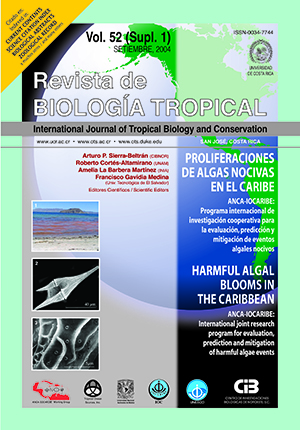Abstract
Analyses of ciguatoxicity in the great barracuda Sphyraena barracuda and quantity of toxic benthic dinoflagellates on coastal reefs (correlated with the number of cases of human ciguatera intoxications in Puerto Rico) were used to construct a model formulated on data obtained during the period of 1985-1988. The validity of the proposed model has been questioned by recent data obtained during the period of 1990-2000. Barracuda ciguatoxicity no longer showed a prominent seasonality while the fraction of randomly caught barracuda that were ciguatoxic significantly increased during this period. These two changes, accompanied by the discovery that ciguatoxic fish contained a variety of multiple toxins, appear to be correlated with the steadily increasing periods of elevated sea surface temperatures in this region.References
Ashton, M., T. Tosteson & C. Tosteson. 2003. The effect of elevated temperature on the toxicity of the laboratory cultured dinoflagellate Ostreopsis lenticularis (Dinophyceae). Rev. Biol. Trop. 51 (Supl. 6): 1-6.
Ballantine, D.L., T.R. Tosteson, H.D. Durst & A.T. Bardales. 1988. Population dynamics and toxicity of natural populations of benthic dinoflagellates in southwest Puerto Rico. J. Exp. Mar. Biol. Ecol. 119: 201-212.
Beddow, T.A., J.L. Van Leeuwen & I.A. Johnson. 1995. Swimming kinematics of fast starts are altered by temperature acclimation in the marine fish Myoxocephalus scorpius. J. Exp. Biol. 198: 203-208.
Halstead, B.W. 1967. Poisonous and Venomous Marine Animals of the World. U.S. Government Printing Office. Washington D.C.
Legrand, A.M., M. Fukui, P. Cruchet, Y. Ishibashi & Y. Yasumoto. 1992. Characterization of ciguatoxins from different fish species and wild Gambierdiscus toxicus, pp. 25-32. In T.R. Tosteson (ed.). Proc. Third Inter. Conf. Cigua. Fish Poisoning, Polyscience Publications Inc., Quebec, Canada.
Lewis, N.I., S.S. Bates, J.L. McLachlan & J.C. Smith. 1993. Temperature effects on growth, domoic acid production, and morphology of the diatom Nitzschia pungens f. multiseries, pp. 601-606. In T.J. Smayda & Y. Shimizu (eds.). Toxic Phytoplankton Blooms in the Sea, Elsevier, New York.
Lewis R.J., M. Sellin, M.A. Poli, R.S. Norton, J.K. MacLeod & M.M. Sheil. 1991. Purification and characterization of ciguatoxins from moray eel (Lycodontis javanicus, Muraenidae). Toxicon 29: 1115-1127.
Oshima, Y., H. Itakura, K.-C. Lee, T. Yasumoto, S. Blackburn & G. Hallegraff. 1993. Toxin production by the dinoflagellate Gymnodinium catenatum, pp. 907-912. In T.J. Smayda & Y. Shimizu (eds.). Toxic Phytoplankton Blooms in the Sea, Elsevier, New York.
Pitcher, G.C., D.A. Horstman & D. Calder. 1993. Formation and decay of red tide blooms in the southern Benguela upwelling system during the summer of 1990/91, pp. 317-322. In T. J. Smayda and & Y. Shimizu (eds.). Toxic Phytoplankton Blooms in the Sea. Elsevier, New York.
Pottier, I., J.P. Vernoux, A. Jones & R.J. Lewis. 2002. Characterization of multiple Caribbean ciguatoxins and congeners in individual specimens of horse-eye jack (Caranx latus) by high performance liquid chromatography/ mass spectrometry. Toxicon 40: 929-940.
Senthilkumaran, B. & K.P. Joy. 1995. Changes in hypothalamic catecholamines, dopamine-beta- hydroxylase, and phenylethanolamine-N-methyl transferase in the catfish Heteropneustes fossilis in relation to season, raised photoperiod and temperature, ovariectomy and estradiol-17-beta replacement. Gen. Comp. Endocrin. 97: 121-134.
Tosteson, T.R., D.L. Ballantine & H.D. Durst. 1988. Ciguatoxic barracuda frequency in southwest Puerto Rico. Toxicon 26: 795-801.
Tosteson, T.R., D.L. Ballantine, C.G. Tosteson, V. Hensley & J. Bardales. 1989. Associated bacterial flora, culture growth and toxicity of the benthic dinoflagellates, Ostreopsis lenticularis and Gambierdiscus toxicus. J. Appl. Environ. Microbiol. 55: 137-141.
Tosteson, T.R., R.A. Edwards & D.G. Baden. 1992. Caribbean ciguatera and polyether dinoflagellate toxins: Correlation of ciguatoxin with standard toxins. pp. 89-102. In T.R. Tosteson (ed.). Proc. Third Inter. Conf. Cigua. Fish Poisoning. Polyscience Publications Inc., Quebec, Canada.
Tosteson, T.R. 1995. The diversity and origins of toxins in ciguatera fish poisoning. P.R. Health Sci. J. 14: 117-129.
Tosteson, T.R., R.F. Bard, I.M. Gonzalez, D.L. Ballantine & G.S. Bignami. 1995. Toxin Diversity in the Ciguatera Food Chain, pp. 73-87. In Y. Hokama, P.J. Scheuer & T.Y. Takeshi (eds.). Proceedings of the International Symposium on Ciguatera and Marine Natural Products Asian Pacific Research Foundation, Honolulu, Hawaii.
Tosteson, T.R., D.L. Ballantine & A. Winter. 1998. Sea surface temperature, Benthic dinoflagellate toxicity and toxin transmission in the ciguatera food chain, pp. 48-49. In B. Reguera, J. Blanco, M.L. Fernández & E. Wyatt (eds.). Harmful Algae. Xunta de Galicia, Spain, & IOC, UNESCO.

This work is licensed under a Creative Commons Attribution 4.0 International License.
Copyright (c) 2004 Revista de Biología Tropical

